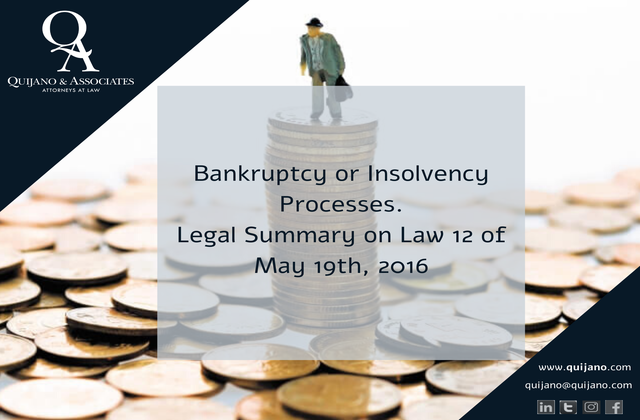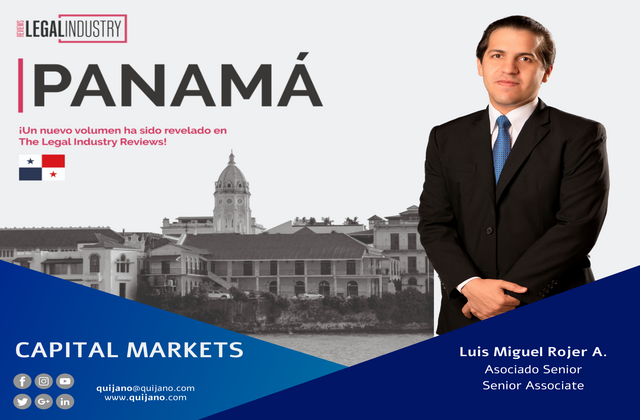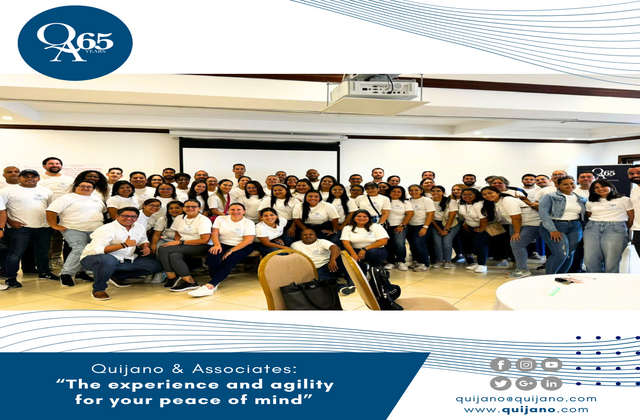Bankruptcy or Insolvency Processes | Legal Summary on Law 12 of May 19, 2016

- Background and Justification of the Summary
Due to adverse situations brought with it by the pandemic generated by Covid-19, some well recognized customers and companies in the market, have expressed their interest in learning more about Law N° 12 of May 19, 2016 “Which establishes the Bankruptcy or Insolvency Processes Regime and Dictates Other Provisions” (hereinafter the Insolvency Act), so then, through this brief summary, we will proceed to make the considerations relevant to the case.
As a preliminary event of relevance, we must mention that through the Insolvency Act or Law 12 of 19 May, 2016, the Bankruptcy or Insolvency Processes Regime was established in the Republic of Panama which purpose is the protection of credit and creditors, through the reorganization process, in order to ensure the recovery and conservation of the efficient enterprise, or by a prompt and orderly settlement of the inefficient enterprise. This law extinguishes the figure of “financial failure” in the Republic of Panama and replaces it with reorganization and judicial settlement.
At this point, although it is not strictly necessary for the purposes of this summary, we would like to highlight the drastic change that this type of process has undergone in Panama, since, if we recall the explanatory statement of the 1917 Code of Commerce, Mr. Luis Anderson illustrated the vision that was maintained in legislating on these issues as follows:
“… Regarding the bankrupts, the project establishes (referring to the Code of Commerce) an innovation that will undoubtedly yield magnificent results in the practice, and it is to presume that any bankruptcy is guilty or fraudulent: it is for the bankrupt to prove otherwise in the criminal trial that must be initiated immediately after the bankruptcy has been declared. Under the current system, to await the civil qualification of bankruptcy and then to initiate the criminal investigation has not been the case that a single failed person has been convicted, a fact that has very serious characters in a Republic like that of Panama, where fraudulent or guilty bankruptcies are frequent. Immediate prosecution and pre-trial detention alone will be effective corrective against unscrupulous traders and non-traders who so much abound in the cosmopolitan cities of Panama, Colón and Bocas del Toro.”
Most of these concepts have been abolished in their entirety, because when analyzing the current insolvency regime, it is clearly established that the subject-matter of that rule (Insolvency Act) is the protection of credit and creditors through the recovery and preservation of the enterprise or by means of the settlement of the enterprise in a prompt and orderly manner.
It should also be borne in mind that the Insolvency Act is a rule of public policy that seeks to protect and secure the national economic order, sources of employment and processes of free competition, all of which is totally contrary to the nature expressed by the Code as explained by Licentiate Luis Anderson.
- Insolvency Act Overview
As we mentioned in our initial considerations, by means of Law 12 of 19 May 2016, established the Bankruptcy or Insolvency Processes Regime in the Republic of Panama which aims to protect credit and creditors, through the reorganization process, in order to ensure the recovery and preservation of the efficient enterprise, or through an early and orderly settlement of the inefficient enterprise.
The referred Insolvency Act considers three (3) major processes to wit, which we will explain succinctly:
- Bankruptcy Reorganization Process
- Bankruptcy Process of Settlement
- Recognition Process of a Main Foreign Process.
- Bankruptcy Reorganization Process
Any natural person or legal entity may be subject to the reorganization process, provided that he is in a situation of default, imminent insolvency or foreseeable lack of liquidity.
Under the Insolvency Act, they ones entitled to request a reorganization are the following:
- The debtor or his/her representative;
- The debtor’s creditors duly organized as a General Meeting of Creditors, through their representative; and
- The representative of a foreign bankruptcy proceeding.
- Application Requirements
The debtor´s reorganization request must contain the following documents:
- In the case of a trading company, an authenticated copy of the Minutes of the Shareholders’ Assembly or the relevant body, in which the resolution to benefit from the reorganization process be it known;
- Explanation of the reasons for default, impending insolvency or foreseeable lack of liquidity;
- Audited financial statements, for the last fiscal year, issued by an authorized public accountant;
- Interim financial statements for the last quarter prior to the date of the request, certified by an authorized public accountant;
- Inventory of assets and liabilities with a cut on the same date indicated in the previous numeral, certified by an authorized public accountant;
- List of goods, where they are located and the encumbrances affecting them;
- Relationship or summary of pending processes;
- Workers’ payroll or list of their collaborators, corresponding to the month prior to the request;
- Project of reorganization of the debtor stating the financial, organizational, operational or competitive restructuring, leading to the resolution of the causes of default, imminent insolvency or foreseeable lack of liquidity, which will be made available to interested parties once the application is accepted.
- About the Reorganization Process:
Once the request for voluntary reorganization has been submitted, the judge of the case, by order shall declare its opening and shall appoint a insolvency administrator, who has the function of knowing the state of the debtor’s business and safeguarding his assets and assets and who may act as moderator in negotiations between the parties, as well as requesting conservation measures to preserve the interests of the creditors.
The order for admission issued by the competent court must be published in a national circulation newspaper for five (5) consecutive days, in order to summon all creditors and interested parties in the proceedings to appear within a twenty (20) days term and to prove their capacity of creditors of the reorganized.
Creditors have a term of twenty (20) days, counted from the last publication of the order opening the process in a national circulation newspaper to verify their claims before the court and after the term has expired, the Insolvency Practitioner must submit to the court a list of verified credits to perform the first Creditors General Assembly of to discuss the reorganization plan proposed by the insolvent.
After all the credits submitted are verified and accepted, the insolvency practitioner shall convene the respective meetings and negotiations of the Creditors General Assembly, which must be attended by an absolute majority of creditors to be considered effective by the statutory quorum and at which the draft reorganization proposed by the debtor, as well as the adhesions, observations, and/or recommendations submitted by the creditors, shall be discussed.
For the reorganization agreement to be approved, it must be voted on by the absolute majority of creditors representing at least sixty-six per cent (66%) of the entire mass of the liability and in the event that this requirement is not met, the settlement process may be initiated.
The reorganization agreement must include all recognized credits.
It is important to note that for the payment the rights of priority or privileged credits will be taken into account and in general the preferences established legally will be met, for which a schedule for the implementation of the agreement will be approved.
- Bankruptcy Process of Settlement
The Bankruptcy Process of Settlement proceeds when the debtor ceases to pay an obligation that appears in an executable instrument resulting from acts of commerce, when the drawee has three or more executions completed against him, provided that he has not submitted sufficient assets for the payment of the entirety and when they are concealed, or the latter leaves his business or closes his commercial establishment , without having appointed a representative with powers and means to fulfil his obligations.
If the above conditions are met, such a process may be initiated directly, or to request the forced opening by a creditor without going through the bankruptcy process of reorganization that we have explained prior to these lines, or after the creditors’ board of the reorganization process, if they are unsuccessful or, finally, after the approval of the reorganization agreement if it is breached or is impossible to implement.
The competent court shall issue the order for a declaration of settlement at the request of the following persons:
- When requested by the debtor or his/representative (voluntary);
- At the well-founded request of a creditor (forced); and
- At the request of the representative of a foreign insolvency proceedings.
Under the Insolvency Act, the voluntary settlement (made by the debtor himself) must be accompanied by the following documents:
- Authenticated copy of the Minutes of the Shareholders’ Assembly or of the relevant body, in which appears the resolution to benefit from the bankruptcy process of settlement, in the event of a trading company;
- List of their assets, place where they are located and the encumbrances affecting them;
- Relation of pending processes;
- Status of its active and passive debts, the name and domicile of each one of the debtors and creditors, cause of the debt, term and guarantee;
- Workers’ payroll or list of collaborators with indication of employment benefits. Social Security due and privileges;
- Exposure of the reasons for settlement;
- Audited financial statements, for the last fiscal year, issued by an authorized public accountant;
- Interim financial statements for the last quarter prior to the date of the request, certified by an authorized public accountant;
- Names and domicile of partners and their capacities;
- Accounting records.
According to the Insolvency Act, where the settlement is forced, in other words, when the settlement is filed by means of lawsuit by a creditor, it must be accompanied by the following documents:
- Evidence establishing the causality relied on;
- Certification of Judicial Deposit for the sum of a thousand balboas (B./ 1,000) consigned in cash at the National Bank of Panama.
Upon submission of the request for the opening of the bankruptcy process of settlement, an initial hearing shall be held at first instance (prior to the commencement of the execution), an initial hearing at which the debtor may consign the funds for the payment of the demanded credit, or enter into an agreement with the claimant on the payment of the credit for the amounts claimed, or those agreed in the negotiation.
At this hearing, the creditor may also negotiate to submit to the bankruptcy process of reorganization (explained in point IV of this summary), or to yield to the claim. If the debtor yields to the claim, the court shall issue the order for a declaration of settlement.
– Of the Declaration of Settlement Order
The Declaration of Settlement Order shall contain the following elements, orders, or clarifications:
- Setting of the settlement status in the capacity of “for now”, setting the date of default on the day of filing of the request;
- The prohibition on the debtor from being absent from the domicile of settlement;
- The seizure and deposit of goods, books, papers and documents;
- The designation of the liquidator and his alternate and the order to the liquidator to seize all of the debtor’s assets, books and documents under inventory;
- The liquidator’s provisional fees;
- The order to the post offices to deliver to the liquidator correspondence intended for the debtor;
- The order to accumulate to the proceeding all of the pending lawsuits against the debtor that may affect his assets;
- The warning to the public to not to pay, or deliver goods to the debtor and the order to persons who have the debtor’s property or documents, but rather to make them available to the liquidator;
- The citation by edict to all national and foreign creditors so that within twenty (20) days, counted from the day following the publication of the order for a declaration of settlement, submit their claims with the documents supporting them. The edict remains fixed ten (10) days and is published in a national circulation newspaper for five (5) days in a row.
- The warning to those who owe the debtor not to make payments to the debtor, but to the liquidator;
- The order to register the settlement resolution to the Public Registry of Panama, in each of the properties belonging to the debtor and in the registration of the debtor company, if applicable;
- The call of creditors to the Creditors General Assembly, with the date, day and time of the first meeting;
- Prohibition of administrators, partners, managers from having any good that is part of the debtor’s liquidable equity or from making payments or payment arrangements on their obligations; and
- The communication to the Social Security Fund, the General Directorate of Revenue, and the Municipality of the debtor’s domicile, so that these institutions are presented to the process in the event of having claims against the debtor.
It is necessary to explain that, from the declaration of settlement, interest against the mass will no longer be counted, unless they are loans guaranteed by pledge or mortgage.
The liquidator will then proceed to form an inventory of the debtor’s assets, with the express value of those assets and the first Creditors General Assembly will take place where the claims of the debtor will be verified.
Agreements reached must be approved by the vote of half plus one of the creditors present on the Board. However, after this credit verification board, the debtor may propose to go to the reorganization, provided that he has the consent of thirty (30%) of the creditors with voting rights.
Once all the goods have been sold, the liquidator shall proceed to draw up a report specifying the goods sold, their product, the costs incurred, the amounts deposited, the credits that could not be collected and those pending lawsuits and the like, of which a project will be submitted for the distribution of existing credits among creditors.
After the settlement of the mass of assets, the judge proceeds to the final distribution among the creditors according to the rules of preference or priority established legally and then the liquidator submits his final report to the Board of Creditors and once approved the contest is concluded with the declaration issued by the judge.
- Recognition of a Foreign Process
The Insolvency Act provides in Articles 225, 230 and 231, that it is possible to request the opening or recognition of a major foreign reorganization process, and also includes as one of the immediate effects of such recognition, the impossibility of initiating enforcement proceedings against the debtor and the suspension of those ongoing proceedings.
In this vein, it should be mentioned that, in accordance with the provisions of article 230 of the Insolvency Act, with the recognition of the foreign process in Panama, the right of the debtor enterprise to transmit, tax, or dispose of any form of its assets is suspended.
Article 230. Effects of recognition of a foreign main proceeding. From the recognition of a foreign process that is a main process:
1. No enforcement proceedings may be brought against the debtor, and those already under way shall be suspended, and the foreign representative and the debtor shall be legally entitled to apply, severally or jointly, for a suspension of the proceedings and to plead the nullity of the proceedings or of the procedural actions subsequent to the recognition of a foreign main proceeding.
2. Any right to transfer or to encumber the debtor’s assets, or to otherwise dispose of those assets, shall be suspended, except in the case of an act or transaction in the ordinary course of business. Any act entered into or executed in contravention of the provisions of this subsection shall be null and void and may be so declared by the competent court.
The provisions of this article shall not affect the right to request the institution of proceedings under this Law or to submit credits in such proceedings.
In addition, if the debtor or the foreign Court that is aware of the case, wishes to have greater protection over the debtor’s assets, he may apply to the Fourth High Court of the First Judicial District (Competent Court in Panama under section 214 of the Insolvency Act, but which has not been physically created) from the initial written petition of request or once the foreign process has been recognized, the protective measures it deems necessary provided that they are those listed in Articles 229 and 231 of the Insolvency Act.
There is another important protection measure in the Insolvency Act in Article 39, which prevents the debtor enterprise from being incapacitated or disabled from contracting with state entities, and prohibits the reorganization process from being invoked as a cause for administrative termination of the Contract.
Article 39. Bankruptcy Financial Protection. While the bankruptcy financial protection is in force:
1. No executive proceeding, execution of any kind, restitution of property or eviction against the debtor may be initiated, except as provided in this Law. For such purpose, the terms of limitation shall be suspended.
2. All contracts entered into by the debtor shall remain in force and shall be subject to the terms of payment. Consequently, they may not be unilaterally terminated early, or their performance may be required early, or the guarantees contracted may be enforced, invoking as grounds the commencement of a reorganization proceeding.
However, the enforceability of statutory or contractual interest shall be suspended, except for secured interest. The suspension will last until the Board approves the Reorganization Agreement, in which it may establish conditions on the applicable interest rate or the collection, in full or in part, in each case.
- The debtor may not be incapacitated or disqualified from contracting with state entities for submitting to the reorganization proceeding, nor may this situation be invoked as a cause for administrative termination of the contract.
The judge in the case shall declare the actions taken in contravention of numerals 1 and 2 of this Article null and void, by order which does not admit any appeal.
To conclude with the generalities and advantages of this figure, we should mention that in Panama there is no differentiation between creditors on the basis of their nationality, so under the Insolvency Act, any creditor, regardless of their nationality, may request the opening of the settlement process under the Insolvency Act, so that rule in Articles 211 and 223 expressly provide that foreign creditors will enjoy the same rights as national creditors with respect to the opening of a process in the Republic of Panama and to participate in it.
- Conclusions
- By means of the Insolvency Act or Law 12 of May 19, 2016, the insolvency proceedings regime was established in the Republic of Panama that aims to protect credit and creditors, through the reorganization process, in order to ensure the recovery and conservation of the efficient enterprise.
- The Insolvency Act extinguishes the figure of “bankruptcy” in the Republic of Panama, and replaces it with reorganization and judicial settlement.
- Any natural person or legal entity may undergo the reorganization process, provided that he is in a situation of default, imminent insolvency or foreseeable lack of liquidity.
- The ones who may initiate or request a reorganization (i) the debtor or his representative, (ii) the debtor’s creditors duly organized as a Creditors General Assembly, through his representative; and (iii) the representative of a foreign insolvency process.
- For the reorganization agreement to be approved, it must be voted on by the absolute majority of creditors representing at least sixty-six percent (66%) of the entire mass of the liability.
- The insolvency process of settlement proceeds when:
- The debtor ceases to pay an enforceable obligation resulting from acts of trade, provided that the drawee has three or more executions against him and has not submitted sufficient assets for the payment of the totality.
- When they hide, or the debtor leaves his businesses.
- When the debtor closes his commercial establishment, without having appointed a representative with powers and means to fulfil his obligations.
- The Judicial settlement is voluntary when requested by the debtor and enforced when presented by a creditor.
- Since the declaration of settlement, interests against the mass are no longer counted, unless they are loans secured with pledge or mortgage.
- The immediate effects of the recognition of a foreign main process of insolvency are:
- The impossibility of initiating enforcement proceedings against the debtor.
- The Suspension of those processes in progress.
- Suspension of the debtor’s rights to transmit, encumber, or dispose of any form of his assets.
- Impossibility to use the reorganization process or recognition of a foreign main process as a cause for termination or termination of the contract.
- The Insolvency Act, article 39, prevents the debtor enterprise from being incapacitated or disabled from contracting with state entities, and prohibits the invoking of the reorganization process as a cause for administrative termination of the Contract.
- The Insolvency Act does not provide for any differentiation between creditors based on their nationality.




